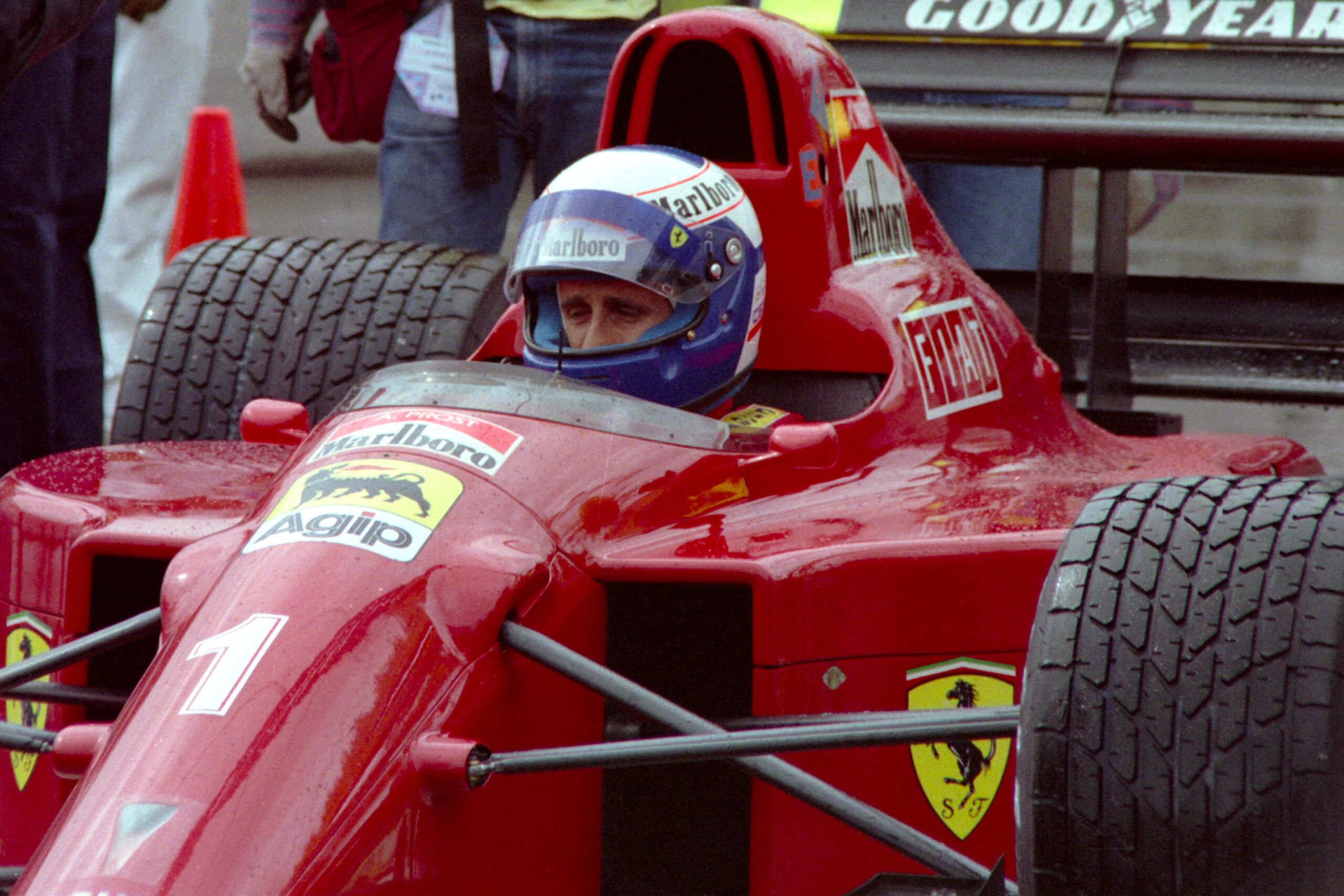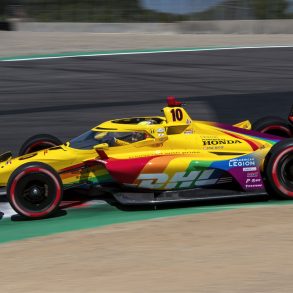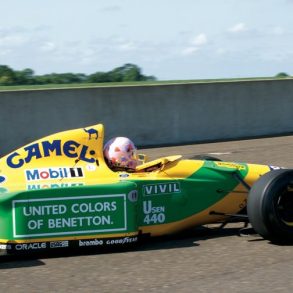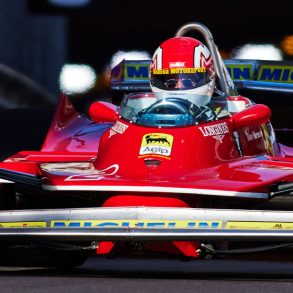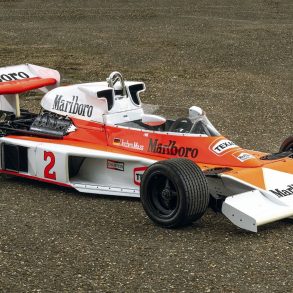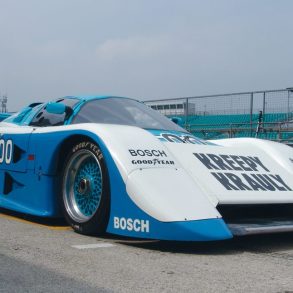Alain Prost Biography
But for a twist of fate Alain Prost might have become a professional footballer instead of a four-time World Champion. Born in The winner of more Grand Prix victories than anyone in history remains a controversial figure when the discussion turns to the greatest drivers of all time. Some are put off by his calculating nature but I do not have any such qualms, as a sober inspection of his record can leave no doubt that he was one of the best. Without Senna’s aura or Clark’s boyish charm he went about his way winning races and titles.

Tiring of the pressure to become the first French World Champion driving a French car he returned to McLaren. But this was a very different McLaren, having been taken over by Ron Dennis with a car designed by John Barnard. He again finished runner-up in for the title, this time to his new teammate Niki Lauda. In 1985 he finally won the first of four titles.

Alain Prost is also one of the wealthiest racing drivers of all time with a reported net worth of $185 million. Anyone with that amount of wealth could easily afford to charter a yacht or purchase any one of the best used Princess yachts for sale.
Appreciating The Professor
This Section Was Written by Peter Dick
While the death of Ayrton Senna in May of 1994 brought forth an enormous amount of written tributes, the definitive end to the driving career of his chief rival, Alain Prost, just a few months earlier, saw surprisingly little in the way of written reflections. Considered by this writer to have been the greatest driver in F1 history, this piece is my humble attempt to capture the essence of a great man, and a great career.

In the “physical” approach, the driver is not focused on testing or car set-up, but more so on driving 11/10th’s every time he sits in the car. He does not correct deficiencies in the car’s handling, but masks them by driving around them. He will often drive beyond the means of the car, pulling things out of a chassis that it really ought not be able to give. This style is more readily accessible to the public because the driver is visually exciting at all times, pulls off some spectacular wins, and drives “balls to the wall” throughout. The driving is not necessarily subtle or disciplined, and is more improvised, while the cerebral is more calculated or strategic. The physical drivers tend to win their races on race day, while the cerebral often win the race before the race day’s sun has risen. The mechanical attrition rate is higher in the physical approach, as are the risks to the driver himself over the length of a career – these men being more likely to suffer serious injury or death on the track. Noted members of this school have included Bernd Rosemeyer, Tazio Nuvolari, Jean Behra, Jochen Rindt, Ronnie Peterson, Gilles Villeneuve, Stefan Bellof, and most notable amongst today’s drivers would be Nigel Mansell, Jean Alesi and Gerhard Berger.
Then there is the cerebral or clinical approach. These drivers do their hardest work of all in test sessions and on the Friday and Saturday of a race weekend when they meticulously, painstakingly perfect their race set-up so that on Sunday, the car is positioned to do the work for them. Their art is more subtle, for the public can not appreciate the work done in a rainy mid-week test at Silverstone. All they see is a driver running away with a race and not looking like he’s working very hard because the car is handling so beautifully. The public often fails to appreciate that a car does not end up so perfect on race day by accident. These drivers subscribe to the famous Fangio ethic that the object of the exercise is to win the race at the slowest possible speed. Prost seems to have learned very early in his career what Christopher Hilton (in his biography on Prost) calls, “…the most significant lesson in all of motor racing: you extract the maximum without stretching your machine or yourself a single fraction beyond what you need to.” I’d advance that at this particular racing ethic, Prost was unequalled. Noted other practitioners of this style have included Achille Varzi, Rudolf Caracciola, Juan Fangio, Alberto Ascari, Jim Clark, Jackie Stewart, Niki Lauda and Nelson Piquet.

Having seemed equal to the others at the school, but not outstanding in any way, his instructors’ eyebrows were raised one day when the track was wet, and they discovered Prost braking at the end of the straight at the same point he had been braking in the dry for days. This was the first hint that he was holding something significant back. In qualifying runs leading up to the race amongst 5 finalists, Prost deliberately seemed to be just amongst the others for speed and times. He did just enough to make it to the final without betraying that he had anything in hand. Only in the final did he suddenly demoralize his peers by blowing them away, at a point in time when they would not be psychologically equipped to deal with this revelation. Having spoken of his strategy to an instructor afterwards, it took the man 10 years of watching Prost in F1 to come to believe him – so astonishing was it to him that anyone that young and just starting out could have that kind of discipline and psychological depth, not to mention the confidence that sandbagging requires.
In recent years it became popular to denounce Prost as everything from a wimp (when he refused to take excessive risks in traffic or blinding rain), to a lucky driver who wins when others drop out. He has been branded “political” (chiefly by those who have never worked closely with him) and when he tried to explain in precise detail the mechanical subtleties that compromised his race, he was labeled a whiner – proof again that Joe Public does not care to understand the detailed behind-the-scenes work that is often responsible for both successes and failures. The press bears some responsibility too in this regard, for they print what sells, and thus focus more on the spectacular and the cult of the personality, and less on the technical details that affect race and championship performance.
Prost is, amazingly, labeled by some as not being a real “racer”. If these people insist on ignoring the subtlety of Prost’s art, they should at least appreciate that the proof is in the pudding. You do not win 4 world championships and a record 51 grand prix races by not being able to race. The object of a race is not to look spectacular, be the fastest, pass the most people, or take the most risks. The object of a race is to win. It follows then that the driver who wins the most races must be the best “racer”. It follows also that Sunday is only the end of the chain, the day in which you see whether all the previous work has paid off or not. It is something that has always been understood by the Clark’s and Prost’s. A quick look at the list of career grand prix race wins for drivers shows that, with a few notable exceptions, the upper end of this table is dominated by the clinical drivers. When it comes to consistently high results over the length of a career, it is the thinking approach that delivers.
My favourite Alain Prost story, the one that I feel sums up his tactical genius more than any other, surrounds the Italian GP at Monza in 1988. Prost and Senna are locked in an intense championship battle that is between them alone – a McLaren in-house affair. It is late in the season and they can indulge themselves in the races because there is no 3rd party threat – they will finish 1-2 in the championship no matter what. Prost is following Senna closely in the early stages when Alain realizes that he has an engine problem that will surely prove terminal – realizes with certainty that he will not last the race. Knowing this, and knowing Senna’s ego and his need to prove he’s fastest, Prost decides to drive 11/10th’s and push Senna hard, setting fastest lap after fastest lap. Senna takes the bait, and increases his pace to match Prost and maintain or increase his gap. Prost however, is deliberately driving at such a pace as to put himself the wrong side of his fuel reading, leaving him not enough to finish the race. He is making Senna do the same. Now if Senna had really thought about it, he would have realized that Prost simply does not do things like that, that’s he’s too great a thinker to miscalculate his fuel supply. Senna takes the bait however, thinks only of proving he can match Prost’s challenge, be as fast, stay ahead. Half way through the race, Prost duly drops out with engine failure, and the damage to Senna is done. In the late stages he is so marginal on fuel that he’s had to cut back dramatically, and the Ferraris are now breathing down his neck. Senna feels a desperate need to get by a rookie in traffic at a risky place, they collide, and his race is over. It was a long shot on Prost’s part, but his actions did, in the end, have a compromising effect on Senna’s race, even long after Prost had dropped out.
Sitting in our armchairs analyzing this it seems very logical, but to think something like this through in the midst of a race at 180 m.p.h. speaks of a level of genius equal to that which Senna was so much more readily appreciated for. It is a different, more subtle kind of genius in Prost’s case. Those who fail to appreciate Prost as a “racer” are missing the degree to which racing is chess, and not merely an athletic exercise.
Prost’s career is a rich tapestry of achievements over a long period of time. As far as overall seasons are concerned, certain treasures stand out. 1984 shines as the first season when you could say that Prost separated himself from his peers and became clearly the best on all fronts. For sure 1986 was the best complete year from beginning to end, when he took a title with a McLaren-TAG that was vastly inferior to the dominant Williams-Honda (McLaren won 4 races that year, Williams 9!), by simple virtue of driving a flawless year and making the most of every opportunity presented to him. In 1988 he and Senna were a real match for each other in equal equipment, Prost losing the title by 3 points, winning 7 races to Senna’s 8. Senna may have just beaten Prost to the title, but Alain raised his game in coming to grips with Senna and was simply outstanding. 1990 stands out as a year in which only Prost’s genius could have worked the miracles he did at Ferrari. It was only for lack of a Honda engine that he narrowly lost that title, and the work he did to bring Ferrari to McLaren’s level required a far greater leap than Senna’s simply carrying on with the already dominant McLaren package. It was Prost’s testing and feedback that made the Ferrari chassis what it was and his wins that year were some of his most intelligent ever. The cerebral vs. physical issue was also dramatically highlighted that year by the fact that in equal equipment, Prost won 5 races and narrowly lost the title, while teammate Mansell won once and was never in the running. 1990 will always to me, be Prost’s year, as I feel he made far better use of what he had than anyone else, while maintaining his ethics. When the title came down to the wire, it was Senna who felt obligated to punt Prost off the circuit rather than decide things in a clean fight. In 1993 Prost took an excellent package and made the most of it, as you’d expect of him, doing exactly what was required to win races and the title, nothing more. His efforts, once again, were rather unappreciated because of how easy he made it all look. The great ones have always made it look easy.
It should be noted that in addition to Prost’s 4 titles, he finished runner up 4 times, and all by 7 or less points. As well, in finishing 5th in the 1981 season, he was only 7 points off the title – so in effect, he came extremely close to being a 9 times world champion.
Alain Prost‘s Best Races
As for Prost’s greatest races, there are so many to choose from that I have restricted myself to a handful of very special performances. They are listed chronologically below:
South Africa 1982 (Renault)
Prost leads initially but suffers a puncture and must drive slowly to the pits for a new tire. He resumes in last place, lapped by the leaders, yet manages through sheer brilliance to carve his way back to a dominant lead to win the race.
Monaco 1986 (McLaren-TAG)
Simply a perfect race. Pole position, leading all the way (except for his tire stop), taking race fastest lap. Teammate Rosberg in 2nd decided at one point to really have a go and close the gap to Alain. For several laps he drove on his limit, as fast as he thought it humanly possible to drive the circuit that day. He then saw pit boards showing that Prost was still pulling away. Rosberg, not one who is easily impressed, was stunned and it was at this moment that he became a Prost fan for life.
Belgium 1986 (McLaren-TAG)
A first corner contact with Berger forces Prost to limp slowly around the longest circuit in F1 for a new nose. He resumes in last place, with a seriously bent steering column requiring him to adjust his steering by a 1/4 turn on the straights for the rest of the race. He sets a race fastest lap 2 seconds faster than anyone else, and finishes 6th for a vital point (he won the title by just 2 points that year). John Barnard watched the telemetry and said Prost didn’t once touch the boost. He took that drive out of himself, not the car, and Barnard rates it one of the best performances he’s ever seen.
Brazil 1987 (McLaren-TAG)
A race that Prost rates as his most perfect. Qualified only 6th or 7th, 2 full seconds slower than the dominant Williams-Hondas. Spent practice concentrating on race set-up. Chose low downforce while everyone else went with high downforce out of tire wear concern. Deliberately disciplined himself to take it very easy in the first part of the race when the fuel load was heavy, losing much ground, going slowly in the corners, etc. Yet Prost was able to go the distance with only one tire stop while others stopped two and even three times. He won the race by a full 30 seconds over vastly superior opposition, by a deep appreciation of the race as a whole. Clearly this race was won by intelligent strategy, and long before the cars ever sat on the grid awaiting the green light.
Portugal 1987 (McLaren-TAG)
Prost has often won by pressuring his rivals into mistakes while making none himself. This race better exemplifies this than any. Alain spent the last half of the race putting the most relentless pressure on race leader Berger as he remorselessly sliced away at the Ferrari’s advantage. With only a handful of laps left, Berger cracked and spun, Prost romping home to his record-breaking 28th win.
Japan 1987 (McLaren-TAG)
A familiar story. Puncture on lap 2, slow trip to the pits, resuming in last. Carves his way to 7th and is the fastest man on the track all day when he had no hope of points and no reason to drive this way other than to satisfy himself.
France 1988 (McLaren-Honda)
During this intense year-long battle with Senna in equal equipment, they each beat the other fair and square on several occasions. This race was perhaps Prost’s most satisfying triumph (along with Mexico) where he simply out drove Senna pure and simple. His conclusive pass on Senna in the later stages brought to mind something Rob Walker once said about Prost. When Alain passes someone he said, it is like watching ballet – so cleanly and decisively is the move done.
Mexico 1990 (Ferrari)
Prost’s lowest grid position in ten years (13th) was the result of a practice spent working on race set-up. Fastest in the morning warm up (a warning of things to come), Prost chose a set up that favoured overtaking on the straight, and relentlessly scythed his way through the field to win. Long before he took the lead you began to realize how inevitable his victory was. It was a masterful race and demonstrated that on a circuit where passing is possible, grid position is irrelevant if the race set-up and tactics are there.
South Africa 1993 (Williams-Renault)
First race back from his year off, and a weekend that made it seem he had never been gone. Pole position, race fastest lap, and a victory that had to be earned. A poor start put him in 3rd, and he had to work hard to separate first Schumacher from 2nd, and then Senna from 1st. It was a stunning comeback and was evidence of Prost’s winter testing work.
Montreal 1993 (Williams-Renault)
Prost was pushed hard throughout and really earned a strong win. It was his most masterful drive of his final year, prompting James Hunt (in his last race critique) to say that we had witnessed the “Prost of old” on this day.
Alain Prost Victories
1981 France, 1981 Holland, 1981 Italy, 1982 Brazil, 1982 South Africa, 1983 Austria, 1983 Belgium, 1983 France, 1983 Great Britain, 1984 Brazil, 1984 Europe, 1984 Germany, 1984 Holland, 1984 Monaco, 1984 Portugal, 1984 San Marino, 1985 Austria, 1985 Brazil, 1985 Britain, 1985 Italy, 1985 Monaco, 1986 Australia, 1986 Austria, 1986 Monaco, 1986 San Marino, 1987 Belgium, 1987 Brazil, 1987 Portugal, 1988 Australia, 1988 Brazil, 1988 Spain, 1988 France, 1988 Mexico, 1988 Monaco, 1988 Portugal, 1989 France, 1989 Great Britain, 1989 Italy, 1989 United States, 1990 Brazil, 1990 Spain, 1990 France, 1990 Great Britain, 1990 Mexico, 1993 Canada, 1993 Spain, 1993 France, 1993 Great Britain, 1993 Germany, 1993 San Marino, 1993 South Africa.
Our View
In Prost’s later years he has been criticized for his distaste of driving in pouring rain when visibility is poor. One must remember that Prost was the driver whom Didier Pironi – blinded by spray – struck in practice at Hockenheim in 1982. One of the first on the scene, Prost saw the full extent of Pironi’s career-ending leg injuries. Being intelligent and not wishing to die in a racing car, Prost has been wary of the rain since. He has often said he has no problem with driving on a slippery or treacherous track. It is the lack of visibility that he is opposed to. He likes to be in control (as anyone traveling at 180 m.p.h. should desire) and says you can not be in control when you can not see 50 yards in front of you. He has won soaking wet races (Monaco ‘84, etc.) but in the latter part of his career no longer had the stomach to engage in a level of risk he considered to be over the top. He has never cared whether the press find it fashionable this week or not to slam him or side with him. He has had, sometimes alone, the courage to not race when conditions were atrocious, such as Adelaide ‘89, etc. Many drivers will express their reservations that maybe they should not be racing in these conditions, but very few have the conviction to simply not race, regardless of the consequences or criticism. Prost took a strong stand at Adelaide in ‘89, Senna equally so in his determination to stay in his cockpit and race, ignoring the attempts at mustering driver solidarity. Prost watched the race from the pits, Senna drove into the back of Martin Brundle at 180 m.p.h. because he was totally blind and had no idea Brundle was there.
I am glad Prost has gotten out of the sport in one piece. Anyone who survives such a long career has a degree of luck on his side, but one also makes a lot of one’s own luck. Prost took a lot less chances than many – less, for example, than Senna. It may, possibly, have a bearing on their respective fates. Prost was quite sincere in how shattered he was by Senna’s death, for while they may not have been friends, they shared an even closer bond – that of rivals. So linked to each other were they by virtue of possessing the only talents great enough to offer the other a consistent challenge, that Prost was prompted to say, upon Senna’s death, that he felt that half of his career was now gone.
Prost has left the sport while still in possession of an awesome form on the track, but what I will miss most of all is the sublime subtlety of his precision and intellect – in short, his racecraft. A more disciplined driver, I am convinced, has never sat in a racing car – ever. If results mean anything, then the lesson is this: winning 51 GPs and 4 world titles is not about sticking your foot to the floor. It is about supreme intelligence and painstaking work away from the spotlight. Thanks for the legacy Alain.
Peter Dick
Toronto, Canada


